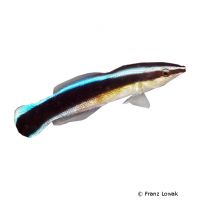Bluestreak Cleaner Wrasse (Labroides dimidiatus)
| Bluestreak Cleaner Wrasse Labroides dimidiatus | |
|---|---|
| Name | Bluestreak Cleaner Wrasse |
| Name Lat. | Labroides dimidiatus |
| Family | Wrasses |
| Family lat. | Labridae |
| Order | Wrasses & Relatives |
| Order lat. | Labriformes |
| Origin | Indo-Pacific, Red Sea |
| Habitat | Coral reefs, lagoons |
| Diet | Carnivore |
| pH | 8.1-8.4 |
| Hardness | 8-10 °KH |
| Behavior | Semi-aggressive |
| Keeping | Individual, pair, harem |
| Reef Compatible | Yes |
| Care Level | Moderate |
| Life Span | 4-6 years |
| Protection | No |
| Metric Units | |
| Size | 10 cm |
| Temperature | 24-28 °C |
| Salinity | 33-36 ‰ |
| Aquarium | ~ 350 l |
| US Units | |
| Size | 4" |
| Temperature | 75-82 °F |
| Salinity | 1.020-1.025 sg |
| Aquarium | ~ 90 gal |
Distribution and habitat
Labroides dimidiatus are widely distributed from the Red Sea, throughout the tropical Indian Ocean to the Pacific, from southern Japan and Australia to the Marquesas Islands. They inhabit coral-rich lagoons, reef terraces and shallow outer reefs with coral cover.
Maintenance
They need a well structured aquarium with rock structures, which offer enough hiding and covering possibilities as well as a lot of free swimming space and a substrate of sand (no coral rubble!). The equipment includes living stones, which act like a biological filter and with their porous structure offer the purifying bacteria and microorganisms settlement area and habitat
Only substrates rich in lime and free of heavy metals may be used as substrate. Filters, skimmers and heaters are necessary to ensure water quality, as well as pumps to simulate tides, swells and bottom currents. Lighting must match the species-appropriate day-night rhythm of the animals
| Salinity: 33-36 ‰ | pH value: 8.1-8.4 |
| Carbonate hardness: 8-10 °KH | Nitrate content: 2-8 mg/l |
| phosphate content: 0.01-0.1 mg/l | nitrite content: 0.0-0.05 mg/l |
For salinity, an average value should be aimed for, which may only vary slightly by +/- 0.5 ‰. Ammonia and ammonium must not be measurable. Special attention must be paid to constantly good water quality.
Diet
In nature they feed mainly on parasites, which they graze from other fish. Since this food is usually not sufficiently available in the aquarium, they need replacement food. The feed change succeeds without problems. The food supply consists of frozen mysis and artemia enriched with vitamins. After habituation, high-quality flake and granulated food is also well accepted
It is recommended to feed small portions several times a day. Regular and varied feeding promotes health and increases resistance.
Behaviour and compatibility
The juveniles, mostly females, are peaceful among themselves and can be kept together without problems. Males are very territorial within the species. Only one male should be kept with one or more females. Towards other fishes they behave peacefully, except for fishes with similar shape and coloration.
Sex dimorphism
They are protogynous hermaphrodites, meaning that most males develop from functional females as needed, and are referred to as "secondary males". No external sexual characteristics are known.
Reproduction and breeding
There are no known reports of successful breeding in the aquarium
Important
They occupy so-called "cleaning stations" to which fish come to be freed from parasites. The active swimmers retreat into small caves overnight. The aquarium must be well covered, as they occasionally jump
It is recommended to keep these typical reef inhabitants together with corals and not to keep them in a fish-only aquarium
If different species are kept together, make sure that the fish match each other in terms of water quality and temperature requirements as well as their social behavior, and that the setup meets the needs of all species kept together. Newly introduced fish must be acclimated slowly to the water in the aquarium
Further literature can be found in your pet store.
References
Text: Werner Winter; Image: Franz Lowak
Source: KUITER, DEBELIUS (2007): Atlas der Meeresfische: Die Fische an den Küsten der Weltmeere, Kosmos Verlag; BAENSCH & DEBELIUS (2006): Meerwasser Atlas Bd. 1, Mergus Verlag; ENGELMANN (2005): Zootierhaltung - Tiere in menschlicher Obhut: Fische, Verlag Harri Deutsch
- Gemäß § 21 Abs. 5 Tierschutzgesetz idgF
